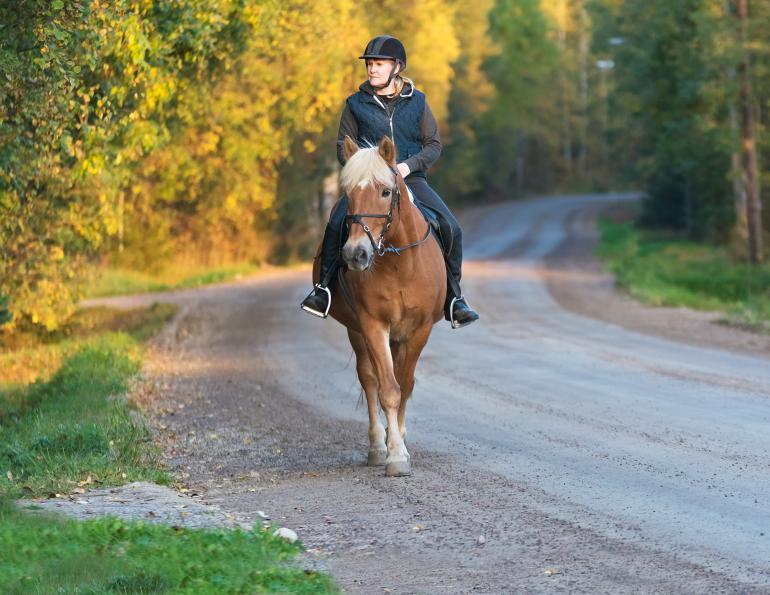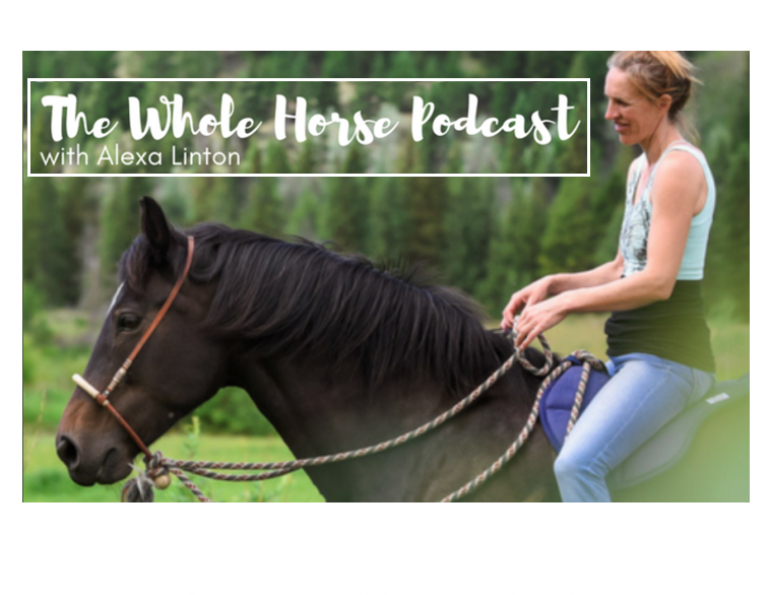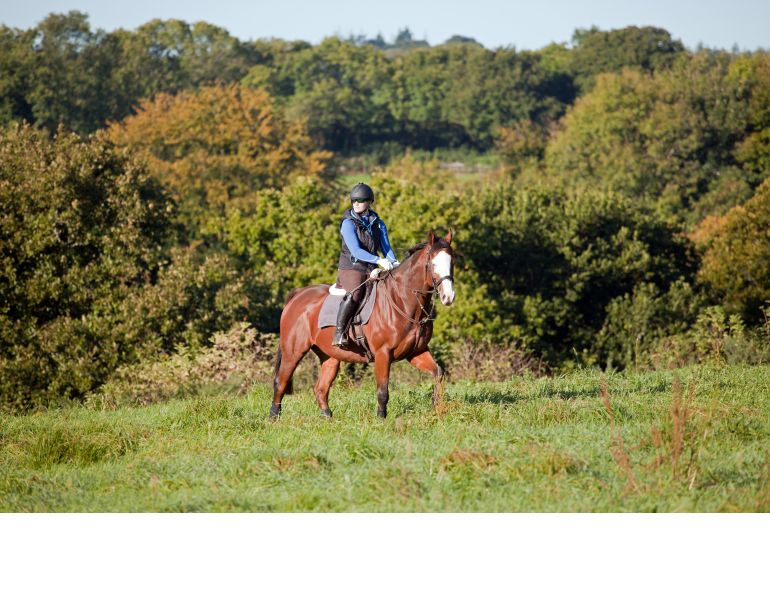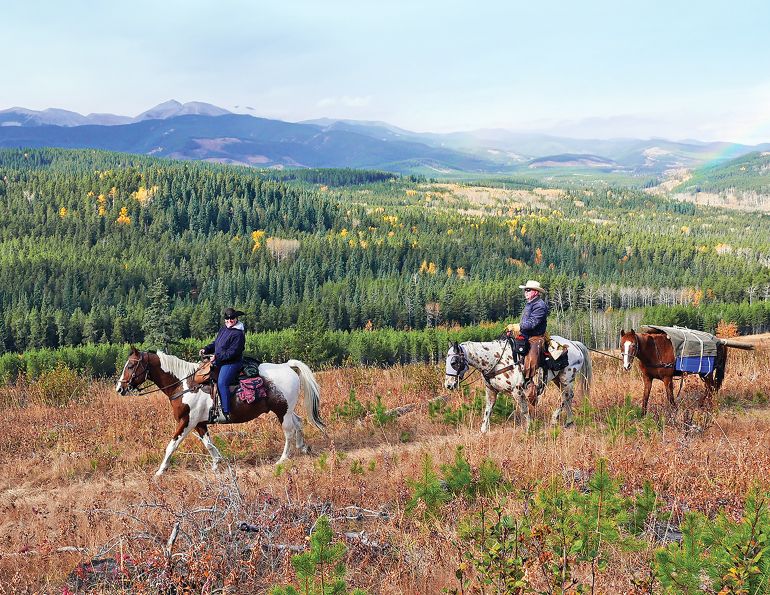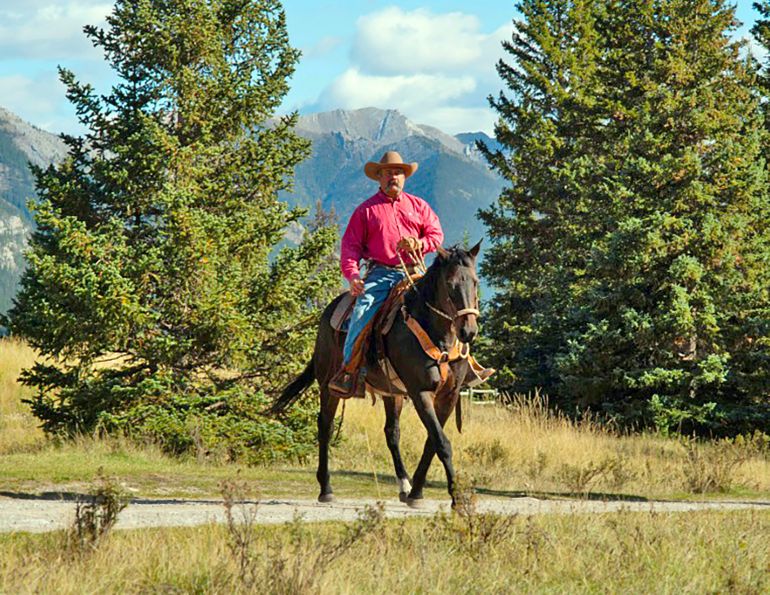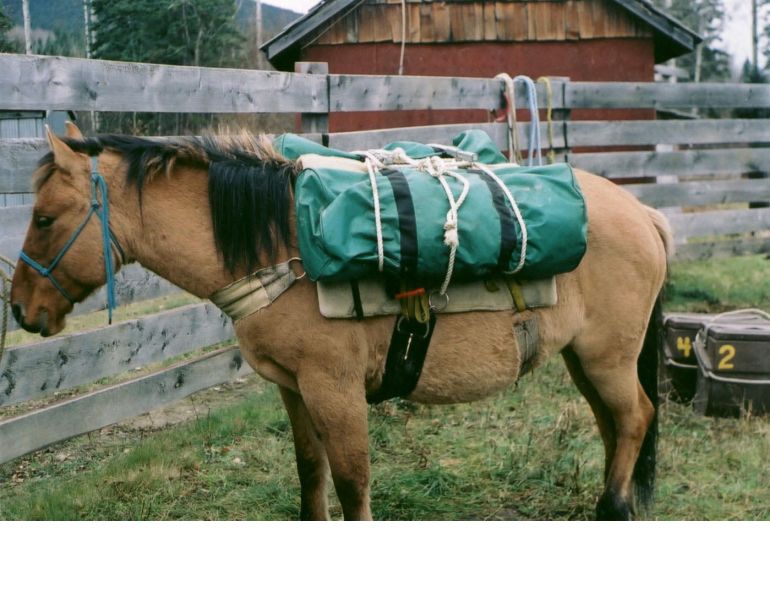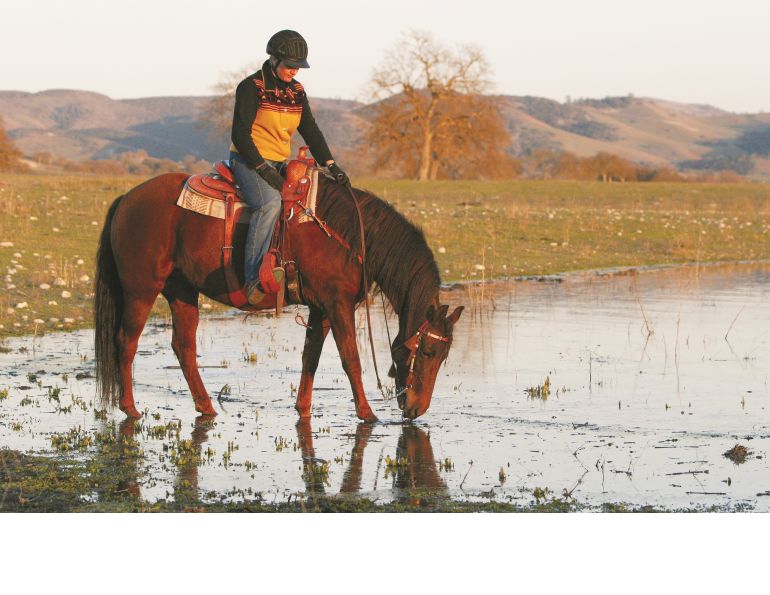By Horse Council BC
As many equestrians take to the roads, keeping themselves and their horses safe while sharing road space with cars, trucks, motorcycles and bicycles is a key concern. Increasing development and traffic volume in rural areas have made road riding a necessity for some riders. For others, road riding is their only option to combat the repetitive nature of arena riding. It is vital that riders seek proper training for themselves and their horses to help them cope with traffic and be safe on the road. The average motorist is not familiar with horses and may be unaware that horses can become easily startled, posing a danger to both rider and motorist alike. They may not know that it is imperative to pass horses slowly and give them a wide berth. Nevertheless, there are many things that you, the rider, can do to increase your safety while road riding.
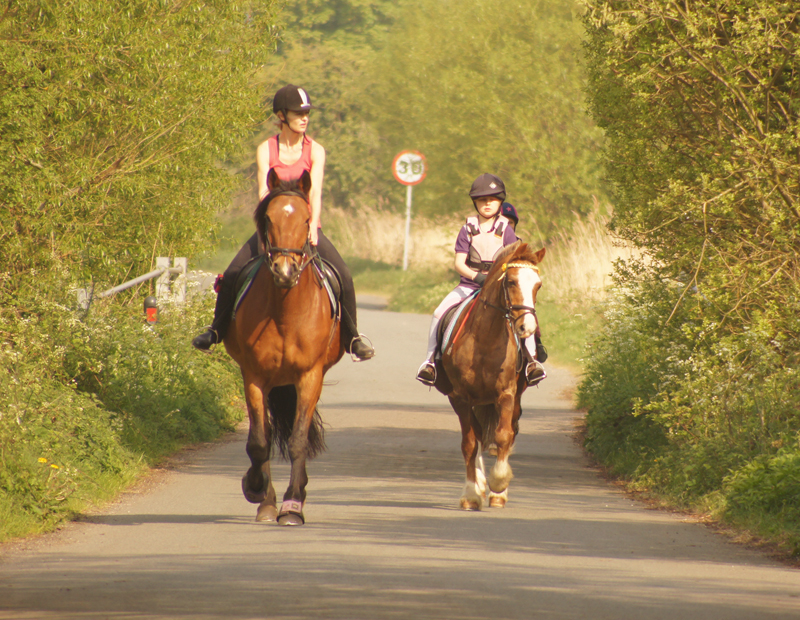
Be Safe
- Before venturing out, ask yourself “Am I ready?” Are you a competent rider, confident and capable of controlling your horse if there’s a problem on the road? Is your horse reliable and road ready? Has your horse been desensitized to the noise and movement of traffic? If not, invest in your horse’s training: find the time, trainer, or clinic to help prepare you both for road readiness.
- Warm up! Lunge or ride your horse at home or in a safe area at walk, trot and lope before heading out on the road. Let him release his pent-up energy in a safe, non-spooky way.
- Select the safest route. Some roads can be dangerous to ride on due to shoulder width, traffic speed, or amount of traffic. Make sure to choose the route with the widest shoulder, the lowest speed limit, and the least amount of traffic as possible.
- Ride single file and obey all traffic signs and signals – remember, your horse is legally considered a vehicle! Ride on the right hand side of the road (with traffic) and yield to pedestrians. Keep one horse length between you and the horse in front.
- Don’t take a young inexperienced horse out without an experienced horse/rider. If riding in a group, let the most visible and experienced person ride closest to approaching traffic.
- When crossing a roadway, select a safe spot to cross. View every bend in the road, intersection, crest of a hill, or construction zone as a hazard. Choose roads with a wide shoulder or other avenues for escape if the need arises. Choose an area to cross where approaching cars are easily seen and heard. Dismount and lead your horse if you are unsure of your safety in the sad.

Highly visible clothing in bright colours and a reflective vest for the rider is a must when road riding. Photo courtesy of Horse Council BC
Be Seen
- Highly visible clothing for the rider is a must when road riding: bright colors during the day, a reflective vest if possible, and definitely a reflective vest at dusk and dawn.
- Reflective leg wraps, brow bands, breast collars and stirrup bars make your horse visible from all sides.
- Another great visibility aid if you’re caught out after dark is a flashing LED safety light that may be attached to your saddle or clothing. These lights were designed for cyclists, but also work great for riders. The intermittent flash of the light attracts a driver’s attention making you more visible and them more aware.
Be Aware
- Flight animals by nature, horses can be unpredictable. A horse may spook and bolt with no warning, so before you hit the road, be sure you know and trust your horse. A nervous or fresh horse may be more difficult to handle away from familiar surroundings. Keep light rein contact at all times – you will be ready to respond to emergencies, and your horse will gain confidence from your guidance.
- Be aware of road surface dangers. Asphalt roads can be slippery especially when wet. Gravel roads with large stones can cause pain for tender footed horses, making them anxious or unwilling to go forward, and loose gravel may cause your horse’s hooves to slip and your horse to stumble. Riding on differing road surfaces may require special considerations for shoeing. Watch for broken glass along the road, culvert pipes and ditches that may be hidden by tall grass, or soft shoulder areas that may be unsafe for a horse to walk on. Unfamiliar objects like shiny aluminum cans or blowing plastic bags can frighten a horse enough to cause it to shy into the road. Be ready for a spook, but don’t be nervous, as your nervousness will be transmitted to your horse.
- Watch for animals along the route, such as barking dogs that may suddenly dart out, cows, pigs, llamas or other farms animals that your horse isn’t accustomed to. Even another horse behind a fence, especially one that is running, can frighten your horse.
- Loose dogs will often chase horses. Walk – never run – past a yard with a loose dog. Your best strategy is to turn your horse to face them and firmly tell the dog to "stay" or "go home." Glance back to see if the dog is safely staying in the yard, but looking back too often may encourage the dog to follow. It’s important to be aware that people can be unpredictable; no matter how educated, there will always be individuals who act irresponsibly. Uneducated motorists may pass too closely, so riders have to be prepared for those drivers who truly don’t know any better.
- Cyclists can be particularly frightening because bicycles approach silently and the riders are often hunched over the handlebars, appearing to the horse like a predator. If you are aware of a cyclist approaching, ask them to speak to you. Hearing the human voice from the “predator” will help ease your horse’s fear.
- If you tense up when a vehicle passes, your nervousness may be transmitted to your horse, so relax, stay calm, cool and centered for your horse’s benefit. If you can get off the road into a driveway or farther onto the shoulder when a vehicle goes by, do so. There is no shame in ducking into a driveway long enough to let that gravel truck speed past.
- Learn to recognize your horse’s pre-spook signs. Before a spook, often a horse’s ears will prick sharply forward, its head will go up, and its neck will tense. It may snort or blow, or start to breathe faster, or it may hesitate, start to veer away, or try to turn around. This is the time to stop and take control of your horse before it spooks, bolts, or tries to run away.
- If you feel unsafe in the saddle, dismount and hand walk your horse. Most experienced riders will agree that when your horse is frightened, you are usually safer in the saddle than on the ground. If you’re on the ground, a frightened horse might jump right into you, stepping on you or knocking you down. But if you are nervous in the saddle, your own nervousness may frighten your horse even more, so in that case it may be safer to hand walk your horse until you reach a point where you feel safe to remount. Whenever safe, lead your horse so it is on your side farthest away from traffic. This at least allows you to push your horse’s hindquarters or shoulder away from you should it start to spin.
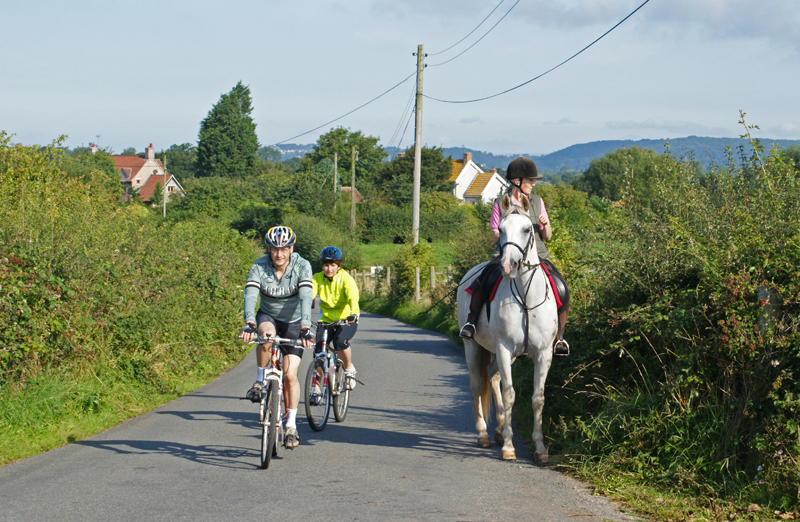
Cyclists can be particularly frightening because bicycles approach silently and can take the horse by surprise. If you are aware of a cyclist approaching, ask them to speak out loud so that your horse is alerted to their presence.
If you encounter a situation where your horse is frightened and difficult to control, try to remember the following:
- Stay calm: Panicking, yelling, or running will only serve to elevate your horse’s anxiety; chances are, if you are stressed, this will be picked up by your horse. Take a deep breath and let it out slowly so your horse can feel you relax
- Let your horse move its feet: A horse’s natural instinct when frightened is to flee. It will help to relieve its anxiety if you let it move its feet, either by turning it in small circles if there is room, or asking it to move its hindquarters over one way and then another, back up, or step forward when safe. Training your horse to step over with its hind feet (disengaging the hindquarters) on cue is crucial to trail and road safety – being able to disengage the hindquarters of your horse is like knowing how to take your car out of drive.
- Let your horse check out the threat on his own time: If your horse is frightened of something that is in reality non-threatening, like a mailbox or a culvert, the first choice is to allow your horse to see that what is scaring it poses no real threat. Turn to face it, and let your horse step forward and investigate on its own time, urging it forward gently one step at a time, or not at all. Allowing it to face scary objects and overcome its fear is how to build confidence in your horse for the future. If it’s not a safe place to let your horse face the scary object, move calmly as far away from the threat as you safely can. In an emergency, take to the ditch to get out of the way of a potentially dangerous driver – better to get dirty than be hurt!
- Never RUN from a dangerous situation: Running releases adrenalin which in turn causes your horse to become even more excited. Instead, turn and face what is frightening your horse, allowing it to move its feet if it needs to, or move away as calmly and slowly as possible.
- If you encounter a motorist who poses a danger to horse & rider: It’s tough to think about license plate numbers and descriptions when someone’s trying to run you off the road, so too few people report those near misses and dangerous situations to the police. The more we report, the more aware the authorities will be that a problem exists.
- In case of emergency: If you carry a cell phone, keep it in your pocket, not on your saddle. Make sure you have identification, a hoof pick, and a pocket knife with you. Tell someone where you will be riding and when you expect to return, and whenever possible, ride with a buddy.
This article was reprinted with kind permission from Horse Council BC’s Road Safety Handbook for Equestrians. One of the most successful membership driven multi-breed, multi-discipline provincial equine organizations in Canada, Horse Council BC represents the equine community in BC by collaborating with individuals, businesses, and industry professionals to strengthen communication, education, and safety. For more information about Horse Council BC, and access to further equine educational material free of charge, visit www.HCBC.ca.



